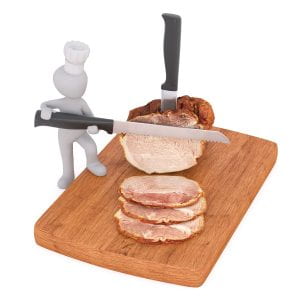
For some, this image shown above could be seen as innocent. At first glance, I saw an animation of a figure wearing a chef’s hat cutting up what looks to be a ham. However, as I continued to stare, I noticed the size of the chef in the photo and how it compared to the size of the meat. He also has his foot proudly standing on the chopping board as if he’s claiming something. Continuing to break down the photo, I started thinking about the tools the chef was using. A nice, wooden chopping board with a steak knife holding down the meat, while the chef used another steak knife to cut the slices. It reminded me of kitchen utensils found in a modern Western kitchen and the meat looked as if it was bought in a grocery store, opposed to people in different countries and cultures who, when killing an animal, will use all parts of the animal, not just one piece. I also thought of the knife going through the meat as being “stuck” which can be compared to the continuous cycle of the meat production cycle. Reproducing the animals, feeding them different kinds of antibiotics and estrogen, bringing them to the slaughter and then selling them in our stores. In the image, the meat is being sliced thinly, which I compared to the mass production of cattle, pigs, ducks, sheep, fish, shellfish, chickens and turkeys that are killed per year for food. It made me think of sandwich meat, something that can be found in hundreds of kid’s lunch boxes or a ham and cheese sandwich readily available in the sandwich section of a grocery store, being bought without a second thought of where it came from or the treatment that the animals were subjected to in order to create that sandwich.
Even though the chef in the image seems to be ambiguous regarding its sex, when I saw the chef cutting the meat, I immediately thought of the chef being a male. Perhaps that is because of the gender stereotypes that come along with dietary choices. In Meat Heads: New Study Focuses on How Meat Consumption Alters Men’s Self-Perceived Levels of Masculinity by Zoe Eisenberg, Eisenberg states that with the consumption of meat, comes being perceived as more “manly” (Eisenberg). Eisenberg also compares what a woman eats when going out to a restaurant to what a man eats, which is typically some kind of meat, like a steak, for a man and salad for a woman (Eisenberg). A vegan blog creator named Ayinde Howell, compared the consumption of meat to smoking cigarettes (Eisenberg). Both have been looked at as being “manly” in society, the more you consume, the more of a man you become (Eisenberg). In today’s society, “women in patriarchal cultures are especially valuable because women, more than men, experience the effects of culturally sanctioned oppressive attitudes toward the appropriate shape of the body” (Curtin). There is so much social pressure put on women to act a certain way, have a certain body type, follow specific diets, wear certain clothing and put on make-up every day or else someone will ask, “are you tired?” From these ideologies that women have to look and act a certain way, what they eat also comes into factor. As stated above regarding women eating salads on a night out opposed to a man eating a steak, there are other foods that would follow this pattern. For example, regarding gendered eating practices, women are looked at to consume fresh fruits and vegetables, make healthy smoothies and follow the latest trends and extreme diets such as drinking apple cider vinegar to get “skinnier,” whereas a man can eat a plethora of meat products such as chicken, steaks, burgers, ribs, wings and hot dogs without adding the weight of societal expectations and constraints. After looking at gendered foods and what was socially acceptable for men to say, eat or do compared to women, it reminded me that “feminists and ecofeminists alike have noted the ways that animal pejoratives are used to dehumanize women, point to the linguistic (and thus conceptual) linkage of women and animals in such derogatory terms for women as “sow,” “bitch,” “pussy,” “chick,” “cow,” “beaver,” “old bat,” and “bird-brain” (Gaard 20). I remember when I first learned where the term “bitch” came from. After figuring out the origin of the word, I was stunned at how popular of a term it was, and how people could stand to use it in their everyday lingo so loosely.
“To be a pet is to have all one’s life decisions controlled by someone else: when and what to eat, how to act, whom to socialize with, whether or not to reproduce. If the situation were offered to humans, we’d call it slavery” -Greta Gaard
Looking at non-human animals from an ecofeminist perspective, they are constrained by our human sense of time and schedules, doing what we tell them to do when we want them to do it; the “suffering of animals” and the “care for animals” can be linked between “sexism and speciesism, between the oppression of women and the oppression of animals” (Gaard 20). In this patriarchal world that we live in, choosing the food we put in our bodies pushes back against conformity and “resist ideological pressures to conform to patriarchal standards” and become once again, wild (Curtin).
Works Cited:
Curtin, Deane. Toward an Ecological Ethic of Care. Contextual Moral Vegetarianism. Hypathia. 1991. 68-71. http://www.animal-rights-library.com/texts-m/curtin01.htm
Eisenberg, Zoe. The Lusty Vegan. Meatheads: New Study Focuses on How Meat Consumption Alters Men’s Self-Perceived Levels of Masculinity. HuffPost. 2017. https://www.huffpost.com/entry/meat-heads-new-study-focuses_b_8964048
Gaard, Greta. Ecofeminism on the Wing: Perspectives on Human-Animal Relations. Women & Environments. 2001. 19-22. https://www.academia.edu/2489929/Ecofeminism_on_the_Wing_Perspectives_on_Human-Animal_Relations
